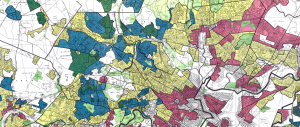This past week we saw two different faces of America. On June 15, “LGBT rights advocates triumphed at the Supreme Court Monday, winning a sweeping decision from the justices that protects gay, lesbian and transgender employees from being disciplined, fired or turned down for a job based on their sexual orientation.” (Politico 2020) The other face was more sinister, focused on hate and cruelty: “The Trump administration on Friday finalized a rule that would remove nondiscrimination protections for LGBTQ people when it comes to health care and health insurance.” (NPR 2020) This means that LGBTQ patients can be denied healthcare or health insurance for gender identity or sexual orientation.
When we talk about housing stability, one of the key metrics is housing cost burden: how much of someone’s income goes to paying for housing. If someone pays more than 30% of their income in housing costs, they are considered cost burdened. If they pay more than 50%, they are severely cost burdened. Up until last week, LGBTQ Americans were at risk of losing their job at any given moment. This reveals the structure of the system that marganalizes LGBTQ Americans and shows how sinister the Trump administration’s rule is: without healthcare, we cannot keep our jobs when we get hurt or become sick; without jobs, we cannot have housing stability.
In addition to the systemic barriers, LGBTQ Americans face direct bigotry from the housing industry. Housing providers were less likely to make an appointment with gay male couples. For every 4.2 available rental units mentioned to heterosexual couples, gay couples were told about 1 fewer unit. They were also quoted higher rents. (Housing Matters 2018) One in five trans people have been refused housing on the basis of gender identity (NCTE 2020). One in 10, or 3.5 million, youths ages 18 to 25 experienced homelessness over a 12-month period, but LGBTQ youth had a risk of homelessness 120 percent higher than heterosexual, cisgender youth. (Housing Matters 2018)
But at the state level, there are possible wins to prevent housing discrimination. Forty-two percent (42 %) of the U.S. LGBTQ population lives in states that do not prohibit housing discrimination based on sexual orientation or gender identity. (lgbtmap.org 2020) Only 22 states have laws prohibiting housing discrimination based on sexual orientation, and 20 of the 22 prohibit housing discrimination based on gender identity. (Urban 2017)
Rhode Island is one of those 20 states that added LGBTQ as a protected category to the Fair Housing Act. This created a legal framework for Rhode Island residents to protect themselves against discrimination based on gender identity and sexual orientation. Other states can adopt similar measures.
These complex systems, housing, poverty, racism, LGBTQ rights, healthcare, and so on, reveal the ways they are interconnected and influence each other. Housing justice work must be both deliberate and specific and consider the intersections of different forms of oppression. While we must act globally to ensure everyone has a safe, healthy and affordable home, we must also act deliberately and specifically to ensure our LGBTQ community have homes.
RESEARCH
A Paired-Testing Pilot Study of Housing Discrimination against Same-Sex Couples and Transgender Individuals | Urban | Diane K. Levy June 30, 2017
Discrimination is limiting LGBTQ people’s access to rental housing | Urban | Diane K. Levy August 2, 2017
State Maps of Laws & Policies that Affect the LGBTQ Community | Human Rights Campaign | April 15, 2020
Equity Map: LGBTQ Nondiscrimination Laws | lgbtmap.org | June 2, 2020
HUD to change transgender rules for single-sex homeless shelters | Washington Post | Paige Winfield Cunningham June 14, 2020
HUD Proposal to Weaken LGBTQ Access to Emergency Homelessness Services Clears OIRA | NLIHC | Jun 08, 2020
Five Facts about Housing Access for LGBT People | Housing Matters | Maya Brennan June 13, 2018
50 Years After Fair Housing Act, LGBT People Still Vulnerable to Housing Discrimination |Sage | Kelly Kent April 11, 2018
Evidence of Housing Discrimination Based on Sexual Orientation and Gender Identity | Williams Institute | February 2016
Ending LGBTQ Housing Discrimination Will Take More Than Reform, Advocates Say | Bustle | Leila Barghouty Dec. 5, 2019
Financial Services and the LGBTQ+ Community: A Review of Discrimination in Lending and Housing | House Committee on Financial Services | House Committee on Financial Services October 29, 2019
New Report on Youth Homeless Affirms that LGBTQ Youth Disproportionately Experience Homelessness | Human Rights Campaign November 15, 2017
2015 U.S. Transgender Survey | National Center for Transgender Equity 2016
STATS
Only 22 states have laws prohibiting housing discrimination based on sexual orientation, and 20 of the 22 prohibit housing discrimination based on gender identity. | Urban 2017
Only 17 states offer protections against discrimanation for gender identity | Human Rights Campaign 2020
One in 10, or 3.5 million, youths ages 18 to 25 experienced homelessness over a 12-month period, but LGBT youth had a risk of homelessness 120 percent higher than heterosexual, cisgender youth. | Housing Matters 2018
One in five trans people have been refused housing on the basis of gender identity. | NCTE 2020
Housing providers were less likely to make an appointment with gay male couples, told them about 1 fewer available rental unit for every 4.2 they mentioned to heterosexual men, and quoted higher rents.| Housing Matters 2018
42% of LGBTQ population lives in states that do not prohibit employment discrimination based on sexual orientation or gender identity (including 5% of LGBTQ population living in states that preempt local nondiscrimination laws) | lgbtmap.org 2020
42% of LGBTQ population lives in states that do not prohibit housing discrimination based on sexual orientation or gender identit | lgbtmap.org 2020



